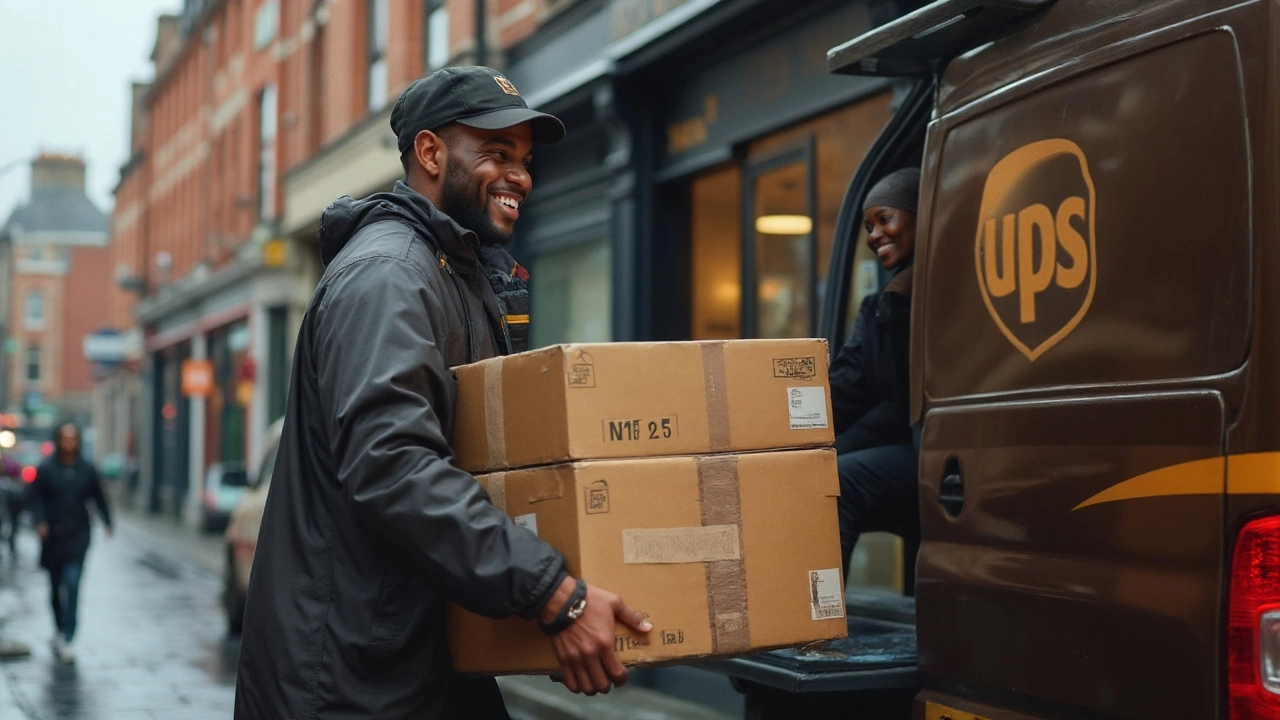It always feels like sending a package should be simple, right? You’ve got a box, something inside that weighs five pounds, and the classic brown trucks everywhere you look. But the first time you actually try to figure out the cost of mailing a 5lb package with UPS, things get a little wild. Prices shift, options multiply, and suddenly you’re staring at service levels like UPS Ground, 2nd Day Air, Next Day Air Saver, each with their own price tags and timelines. And, just to make it more fun, the quote you get can swing by twenty bucks depending on the tiniest detail—like which city you’re shipping to, or how you type in the address. Shipping a five-pound package with UPS in 2025 is almost like booking a flight: you have to know where to look, what boxes to tick, and how to avoid getting stuck with pointless fees. Ready to break down the details and demystify the whole thing?
The Basics: What Affects UPS Shipping Costs for a 5lb Package?
Let’s start with what actually sets the price. A 5lb package might sound pretty straightforward, but UPS doesn’t just slap on a single fee for anything under ten pounds. The reality is, five pounds could cost you barely ten bucks—or it could shoot up to fifty—depending on a handful of factors that UPS has fine-tuned over the decades.
First, there’s distance. UPS shipping zones work a lot like airline routes. The further your package travels from its origin (what UPS calls Zone 2 all the way up to Zone 8 for farthest domestic trips), the more you’ll pay. This means sending a 5lb package from New York to Boston is much cheaper than shipping that same box to Seattle.
Then, look at service speed. UPS Ground is the entry-level option, usually the cheapest, but you might be waiting two to six days. If speed matters—maybe you forgot your niece’s birthday—air services kick in. UPS 2nd Day Air gets it there in two business days, while UPS Next Day Air delivers the next day, but the price jumps significantly.
Don’t forget about package size. Here’s a fun quirk: even if your package weighs five pounds, the size of the box matters. UPS uses something called ‘dimensional weight,’ which is sort of a way for them to make sure they’re paid fairly for huge, fluffy packages that fill up a truck but don’t weigh much. If you stick your 5lb weight in a beach ball-sized box, you’ll get charged for a higher dim weight. Small, tight packages are always cheaper unless they’re oddly shaped—then you might get “large package” or “additional handling” fees added on top.
Finally, account for extras and surcharges. Want a signature on delivery? There’s a fee. Using pickup instead of drop-off? Another surcharge. Rural delivery? That’s extra. UPS even factors gas prices in with fuel surcharges, which change every week.
What’s the Range? Example Costs for a 5lb Package in August 2025
If you’re just after the quick answer, here are some specific numbers based on August 2025 rates.
- UPS Ground: Sending a 5lb box from Los Angeles to Denver (mid-distance zone), you’ll pay around $14.50 if you use a standard-sized box and drop off at a UPS Store. If you’re going from Boston to Miami, it’s closer to $18. For very dense city-to-city routes inside the same state, it can dip as low as $10. Keep in mind, a bigger box will increase this due to dimensional weight even if it’s still five pounds on the scale.
- UPS 3 Day Select: This service costs about $26-$31 for the same package, depending on how many zones it crosses.
- UPS 2nd Day Air: You’re looking at $38 to $44 on average for five pounds, again shifting slightly based on zip codes and box size.
- UPS Next Day Air Saver: If time is gold, overnight delivery of a 5lb box can run from $58 to $75 per package, and sometimes beyond if you tack on pickup, delivery area surcharges, or if you pick a very remote address.
These numbers come straight from the UPS Rate and Service Guide for 2025, and are what I got when I tried a bunch of addresses on the UPS shipping calculator. They do not include extra fees, like a $6.15 signature confirmation or $9.85 for “extended area” delivery. If you need a printed receipt or detailed tracking, expect to shell out a couple dollars more.
And always check for sudden price changes toward the holidays! UPS raises rates every November with a “Peak Season” surcharge that can add $2 to $7 per package, especially for residential deliveries. The crazy part? Even tiny differences in box size can send your quote up or down by three or four bucks. I learned to always measure with a tape measure—UPS will round up to the next inch if you eyeball it and get it wrong!

Ways to Save Money: Tips for Sending a 5lb Package with UPS
No one wants to overpay for shipping, especially if you’re running a small business out of your kitchen, like my friend Judy who bakes sourdough to order and ships it out twice a week. Here’s what I’ve found actually works when UPS starts feeling pricey:
- Compare drop-off choices. Dropping your package off at The UPS Store or authorized outlets is often slightly cheaper than scheduling a pickup from your house. Pickups cost extra—usually $4 to $7 per package, unless you open a business account with weekly pickup rates.
- Box size up. Measure and weigh—don’t guess! Packing your item in the smallest, sturdiest box can save $2–$5 just by dodging dimensional weight pricing or “additional handling” fees. Don’t use a huge box if you don’t need to. UPS gives guidelines for box sizes on their website; stick close to their recommendations for best prices.
- Sign up for My Choice or a Simple Ship account. Personal UPS accounts let you track packages, store addresses, and sometimes access special coupons. Small business? You can get volume discounts starting at just a handful of packages per month. These can take prices down by 5–12%.
- Ship on non-peak days. Shipping out your 5lb box on a Monday or Tuesday usually means less risk of surcharges or delays (which can cause your package to end up using a pricier air service if UPS tries to meet their commitment). Peak days, especially close to holidays, can trigger extra fees, too.
- Double-check with competitors. UPS isn’t always the cheapest game. FedEx and USPS can beat UPS Ground for short-haul packages under seven pounds. But for cross-country or fast shipping, UPS holds its own. Use the online calculators for all three major services before committing.
- Skip add-ons unless you need them. Signature confirmation, extra insurance, and delivery receipts all add up, so use them only if required. A standard UPS shipment comes with $100 of insurance included, which is often plenty for regular mailings.
If you regularly ship from home, investing in a digital scale and tape measure pays for itself after a few shipments—seriously, I learned the hard way after a package of my husband’s electronic gear got upcharged just because the counter clerk measured the box an inch larger than I thought. UPS always rounds up sizes and weights. Good tools keep your costs down and your quotes accurate.
Business Solutions: Cost Factors for Bulk and Ecommerce Senders
Let’s talk business. If you’re shipping more than a few packages a month, your whole pricing structure with UPS changes. Stores, Etsy sellers, or direct-shipping brands have a lot more wiggle room in negotiating shipping contracts, and UPS loves building loyalty with business customers by offering tiered discounts.
For starters, most business shippers get access to something called “Daily Rates,” which are different from what occasional senders see at the counter. These can be 10–25% lower than retail rates depending on volume, average package size, and service speed used most often. If you’re shipping five-pound packages across the country each week, a UPS account manager might help you create a custom rate chart, lowering costs even further when you use their Smart Pickup system or pre-printed labels.
Ecommerce platforms like Shopify, eBay, and WooCommerce integrate directly with UPS, letting you print discounted labels at home. On my small knitwear store’s Shopify account, a five-pound package sent to a nearby city shows up at $13.05 with Ground, versus $15.80 if I go direct to UPS’s customer counter. And because all my info autofills and the label prints in seconds, I dodge the $2 “manual address entry” fee at most counters.
Volume shippers are also eligible for consolidated monthly billing, waived pickup surcharges, and free shipping supplies on request. There’s a real benefit to signing up for UPS’s Simple Rate program, where boxes up to 10 pounds are given a flat fee regardless of how far they travel, as long as they fit the allowed dimensions. In 2025, the Simple Rate for a five-pound box ranges from $12–$18 per shipment within the continental U.S., depending on box size tier. This takes out all the guesswork, which is a beautiful thing if you’re sending gifts to family or making regular online sales.
But don’t forget the extras. For ecommerce deliveries, residential surcharges and peak season fees hit especially hard. From November to January, expect $1.75–$7.50 added for residential addresses. Using the UPS shipping API to automate rate quotes and batch tracking can save a literal headache during busy periods, especially when customers start asking, "Where’s my order?" every night. UPS’s built-in tracking numbers can be shared instantly, making customer updates automatic and keeping your reviews gleaming.

Essential Facts, Common Surprises, and The Bottom Line for 5lb UPS Shipping
Think you’ve seen it all? Here are some final things that often catch people off guard when shipping a five-pound box through UPS:
- Saturday delivery costs extra. Even with air service, you need to specifically choose and pay for Saturday delivery or your box will wait until Monday. This usually adds $15–$22 depending on the city.
- Remote locations equal remote fees. Sending a five-pound care package to a friend’s rural cabin in Montana will tack on an “extended area surcharge” of $9 or more.
- Weight rounding bites. UPS always rounds up: if your box is even 5.1 lbs on their scale, you’ll pay for 6 lbs. The same happens for parcel size.
- Holiday price bumps sneak in. Peak Season Surcharges start in early November and stay until mid-January, quietly adding up if you’re mailing gifts or holiday orders.
- Insurance is included—but only up to $100. If you need more, declare a higher value when shipping. Additional coverage comes at roughly $2.25 per $100 of extra value. For high-ticket items, it’s worth it.
One thing I love is the UPS Money-Back Guarantee: most UPS Air and Express services still offer a refund if your box arrives later than promised—with no questions asked. The only trick is, you have to actually request the refund, and most people never do! If your overnight package shows up two days late, claim your cash back.
To wrap up the numbers: sending a five-pound package with UPS can be quick and cheap, or quick and pricey. For an average domestic route this August, budget $14–$20 for Ground, $26–$44 for faster air, and use every trick in this guide to keep those numbers from climbing higher than they have to. Measure twice, weigh with a digital scale, choose the right service and packaging, and you’ll get the best deal for your five pounds—no matter how many times you ship.





